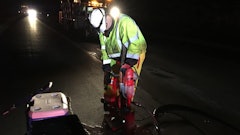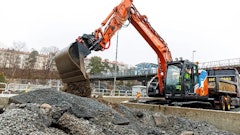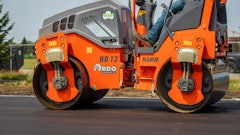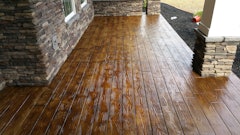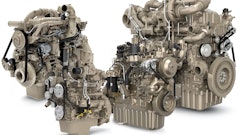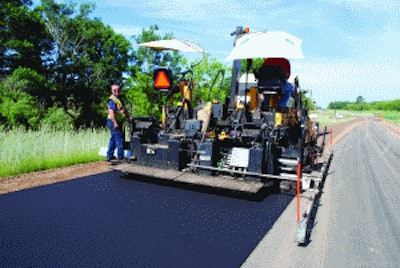
To fight thermal cracking, Crow Wing county hopes to use a warm mix asphalt (WMA) additive to get from a lower-cost PG 58-28 binder the same cold weather performance of the more expensive polymer modified PG 58-34 binder specified in Minnesota for newly constructed low-volume bituminous roadways.
But it also hopes to use the WMA additive to improve binder durability by reducing the premature or "artificial" aging to binder caused by exposure to the scorching heat of the asphalt plant burner.
Crow Wing County is in the second year of testing warm mix asphalt to ameliorate thermal cracking and improve binder durability. Following a test project in late 2008, testing in 2009 included placement of two layers of bituminous mix containing a warm mix additive, and 30% reclaimed asphalt pavement (RAP), on County Road 2.
"One of the hoped-for benefits of warm mix asphalt is greater durability over time," says Wayne Dosh, senior engineering technician, Crow Wing County Highway Department. "One of the issues we struggle with in Minnesota is thermal cracking, It's usually the biggest killer of our roads. One of the ways to get around it is by using 'softer' grades of binder. The performance-grade binders used are based on our ambient temperature extremes, and that kind of spread usually implies polymer modified asphalt. By using a warm mix additive we hope to be able to get the same performance with non-modified oil as with a modified."
But premature aging of binder also is an issue that the county hopes to minimize with warm mix.
"Heat contributes to premature or artificial aging of the binder, which breaks down the oils," Dosh says. "This gets even worse as the mix ages in-place over time. One of the benefits we're hoping for (from the warm mix additive) is to be able to use cheaper binder - PG 58-28, that doesn't require a polymer modifier - with the added benefit of less premature aging in addition to less thermal cracking."
What is thermal cracking?
In bituminous pavements, thermal or low-temperature cracking is non-load associated and appears as transverse shrinkage cracks in the asphalt layer. As frigid ambient temperatures chill the surface, they contribute to tensile stresses in the pavement due to material shrinkage.
Asphalt mixes with high stiffness modulus at low temperatures are very prone to cracking. As mix stiffness is dependent on the stiffness of the asphalt cement, anything that can be done to modify the liquid asphalt in this regard may help fight thermal cracking. And that's what Crow Wing County set out to do in its 2008-09 testing on its roads.
In August 2008, C.R. 108 was paved using warm mix additive, with a 2,000-ft. control section of conventional PG 58-28 hot mix with no polymer. After the winter of 2008-09, average cracks were the same for conventional hot mix and warm mix.
"The key will be in spring of 2010, when the C.R. 108 mixes are two years old," Dosh says. "In this climate, we will see thermal cracking on the 58-28s within two to three years. On the 58-34s they start appearing in about four to five years. Our past practice has been to use 58-34 oils on all new construction on gravel bases or roads. Our goal is to use a less-expensive binder in place of the higher-priced polymer modified binders, and get a similar performance."
C.R. 2 had been constructed in the early 1950s, and had not been overlaid since. By 2008 the road was in bad shape, and late that year underwent the first phase of reconstruction with milling down to the existing base, followed by ripping with dozers, regrading, then fresh virgin aggregate placed just before winter as a driving course.
Then, in summer 2009, C.R. 2 received two lifts of warm mix asphalt as part of the thermal crack test. "Both base and wearing course are the same mix design," Dosh says. The base lift was compacted to 2 in. deep and was followed by a 1 1/2-in. friction course. The road was being paved in two 14-ft. passes, resulting in a 12-ft. driving lane with 2-ft. paved shoulder each way, flanked by 4-ft. gravel shoulders. A total of 20,000 tons of WMA was placed on the just-under five-mile-long project.
"Crow Wing County showed a lot of leadership on this application," says Jonathan MacIver, business development manager, MeadWestvaco Asphalt Innovations.
"The county came to us and wanted more information about the technology," MacIver says. "We focused on the reduced binder oxidation properties of warm mix asphalt, determining whether Evotherm-treated binder without polymer modification can give similar performance to polymer modified mixes for thermal cracking control. We've given the county the support it needs to move forward, but the work has been done almost entirely at the county level."
Benefit in life cycle costs
The county did extensive research into how premature aging develops, and anticipates that over the life cycle of the pavement, the field tests will show the benefit of lower production temperatures.
"The initial rate of oxidation is less for WMA pavements than for HMA, which should slow down the binder aging process and extend the life of the pavement, so long as it's maintained properly," Dosh says. "Based on our analysis, the life cycle cost of a low-volume roadway like C.R. 2 constructed with warm mix PG 58-28 will be lower than a similar road constructed with hot mix PG 58-34, assuming the rate of aging is slower for WMA than HMA."
For the C.R. 2 project, initial cost of the WMA PG 58-28 was $3 per ton less than the HMA PG 58-34 binder, so the test already was ahead in initial cost. More data and time are required for long-term performance answers, but the initial indicators are positive.
Projections of life cycle costs for the WMA C.R. 108 project in 2008 yielded very favorable numbers. The life cycle analysis showed that WMA alternatives would cost less per mile than HMA, the main reason being the extended time to the first rehabilitative overlay. As Crow Wing County is responsible for 613 miles of roadway, the cost savings over the life of the roads using WMA would be some $1 million per year.
Lower fuel costs notwithstanding, the real financial benefit of WMA will come as the life cycle of a pavement plays out, notes the contractor and mix supplier on both the C.R. 2 project in 2009, and the C.R. 108 project in 2008.
"The workability of WMA is fine," says Terry McFarlin, senior vice president of operations, Anderson Brothers Construction Co., Brainerd, MN. "For the crews, with the reduced heat and odor, it's a better climate to work in. There is less fuel consumption at the plant, and warm mix gives the crews a bigger window to work in for rolling patterns. Otherwise, it's basically the same placement procedure as HMA, once you've found your rolling pattern."
At the plant, a small metering device pumps the Evotherm additive directly into the liquid AC line, so it's added as any other liquid additive. "The biggest difference is in the consumption of burner fuel," McFarlin says. "Last year we found a 20% to 23% reduction in fuel oil consumption, depending on the day's particular run. In cost, it's not enough to justify the price of the additive alone, but in the long term, with the lower temperatures of mixing, thus not burning off the light ends of the binder and causing premature aging, it will be a much better product than conventional HMA and that's where you will see the savings."
Increasing RAP content
The WMA test also permitted the county to boost the percentage of RAP used in the mix. RAP that had been removed from the pavement the year earlier was screened and crushed, and stockpiled during the winter prior to reuse in the warm mix.
"In Minnesota the type of binder determines the maximum RAP that can be used, and because we are using PG 58-28 oil - non-polymer modified - we can use up to 30% RAP," Dosh says. "If it were polymer modified we'd be restricted to 20% RAP. That was one of the benefits of using the warm mix additive, as we were able to bump up the RAP another 10%, with further savings."
Warm mix was being delivered by bottom-dump trailers from a portable plant minutes away, and placed by an Ingersoll-Rand/Blaw-Knox PF-3200 paver.
The paver was fed by a Cedarapids windrow elevator. Breakdown rolling was being done by a Cat CB-534D vibratory steel tandem roller, making three passes.
A Cat PS-360B pneumatic roller was making seven passes in the intermediate spot. And a finish roller - an Ingersoll-Rand DD-110HF articulated double-drum compactor - was making five passes in static mode.
Mix was being produced at the plant at or below 235 deg F, compared to a conventional mix produced at temperatures above 290 deg F, and was being placed at about 220 deg F.
WMA temperatures averaged 230 deg F in the windrow, 220 deg F by the paver, and the finish roller was compacting at 130 deg F, which is quite low. "The driving factor is the temperature in the baghouse," Dosh says. "The temperature has to be kept above the boiling point so water will not condense in the bags. We could produce at a lower temperature if not for the baghouse."
The county may get an added benefit. Because WMA is not as dependent as HMA on heat to provide the workability needed to get density, the county may be able to extend its paving season, which is limited in the northern tier of states.
"From what I've seen, WMA will be an excellent way to extend the paving season," Dosh says. "We usually run out of time to pave. We are doing well if after base construction, we get our first course down before snow flies. We typically are not supposed to place asphalt after Sept. 15 in the northern part of the state. And due to weight restrictions following the winter thaw, we can't start hauling heavy loads like asphalt from the middle to the end of May, depending on the kind of winter we've had. If there's been a long, cold winter, it might be the first of June before we can pave. We are looking at a paving season of 120 days, longer if there is a warm fall, but you can't depend on that."




